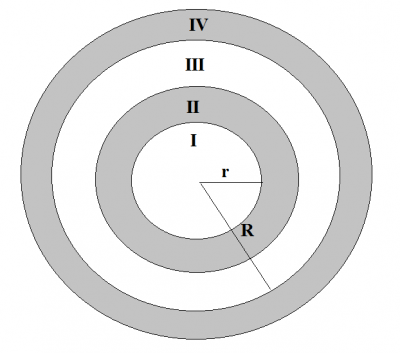BY LETTER
Void Pocket
Technology > Application > Metric Engineering
Technology > Application > Weapons > Metric Weapons
Technology > Technology Levels > Transapientech / Godtech / Clarketech
Technology > Application > Weapons > Metric Weapons
Technology > Technology Levels > Transapientech / Godtech / Clarketech
 Image from Steve Bowers | |
| The interior regions of a void pocket. Region I is the 'pocket', which has a large inner metric diameter. II is a transition region from the pocket to part III, which is a very small region of flat space between the pocket and the warp metric; Region IV is the wall of the warp bubble. Spacetime is flat, except in the shaded regions. R is a small number of nanometres, while r is tens or hundreds of metres. | |
A void pocket is a Fifth Singularity or higher void bubble that can contain complex conventional matter structures and safely release them into the outside universe when the bubble is deactivated.
At the Fifth Singularity, it becomes possible to enclose hardened complex devices within a void bubble at the moment of its creation and later release them intact when the void bubble is deactivated. In many cases, re-enforced nanofacturing systems and a high grade mattercache are enclosed, allowing the controlling archailect to create any of a range of devices before deactivating the surrounding warp bubble to deploy them. Because the interior of a void bubble can be orders of magnitude larger than its exterior, a void pocket may contain objects ranging in size from large swarms of nanomachines to entire medium size spacecraft or anything in between.
In vacuum conditions the opening of a void pocket typically takes a millisecond or less with the effect, to baseline senses, of its contents simply snapping into existence out of nowhere, usually accompanied by a brief flash in the 400-475nm range. High speed sensors, or those rare occasions when local conditions necessitate a slower shutdown, reveal more detail. A gradually opening void pocket may take up to several seconds to fully deactivate and appears as a spherical volume of visual distortion, growing from a single point and expanding to its final size before vanishing. The initial distortion is intense, making identification of the contents virtually impossible without extensive image processing, but as the opening process continues this effect rapidly decreases until the contents of the void pocket are clearly visible just before the bubble itself vanishes. While the bubble is expanding, a faint halo of light plays across the apparent surface of the warp field boundary, due to a small amount of exotic energy being lost as radiant energy as the massive space-time distortions of the void pocket are systematically unwound by the interior machinery. Discussions with occasionally forthcoming archailects indicate that the deactivated machinery is either folded up and removed using Halo technology or occasionally discarded, collapsed down into a microscopic point of tremendous density and left to drift thru the vacuum of space or fall into the core of the nearest planet or sun.
It is also possible for S5 and higher void pocket systems to operate in a 'nested' configuration, with a group of void pockets (each containing its own matter supply, manufacturing systems, or finished devices) being enclosed by a void bubble in turn. Since the interior of each void bubble may be hundreds of meters across, while its exterior is measured in picometers, a great many void bubbles may be enclosed at once, allowing the later deployment of massive industrial or military resources all in an instant.
Since a nested void pocket containing other void pockets is itself still measured in picometers from an exterior frame of reference it, along with many others, may in turn be enclosed in another void pocket, which may be similarly enclosed, and so on and so forth.
The ultimate limit of this process is when the total combined mass contained within the system of nested void pockets (generally consisting of exotic matter machinery, mattercaches, nanofacturing systems, and finished products) equals or exceeds the mass of a black hole with an event horizon larger than the diameter of its outermost void bubble. For a 1 picometer (1e-12m) radius void bubble this limit is reached when the interior mass reaches approximately 1.49e15kg (almost seven times the mass of Halley’s Comet in Sol System).
At the Sixth Singularity, it becomes possible to both create void bubbles as much as a thousand nanometers (1 micrometer) across and to pass a void pocket through the intensely warped space-time that makes up the boundary of a void bubble while leaving both bubbles, and their interior contents, intact. Transit can take place in both directions; with interior void pockets traveling 'outward' through shells of surrounding void bubbles until they exit the outermost bubble (where they may then deactivate and deploy their contents or perform some other mission such as reconnaissance or the direct manipulation of local matter as part of a Halo Drive or Void Swarm ) or 'inward' through the exterior of the outermost void bubble and then down through shells of nested bubbles to some desired location. For 'outward' travel the exterior dimensions of each bubble are irrelevant, but for 'inward' travel, the bubble being ‘entered’ must be of larger exterior dimensions that the bubble entering it.
The capability of S6 void bubbles to enter and exit from other bubbles is most famously demonstrated in the so-called 'Void Ships', which can travel to a location at nearly the speed of light before causing a vast range of equipment and resources to seemly appear out of nowhere at their destination — all without ever being seen.
Related Articles
Appears in Topics
Development Notes
Text by Todd Drashner
Initially published on 18 October 2015.
Initially published on 18 October 2015.






